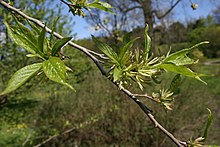Eucommia ulmoides: Difference between revisions
more info |
|||
| Line 37: | Line 37: | ||
==Ethnomedicinal use== |
==Ethnomedicinal use== |
||
The bark is used in [[traditional Chinese medicine]] to treat lower back pain and aching knees, to prevent [[miscarriage]] and to "tonify" the [[yin and yang|yang]].In traditional Chinese medicine, Eucommia bark is used to strengthen the bones and muscles and alleviate discomfort in the lower back and legs. Eucommia bark contains a substance, iridoid glycoside, that has a long history of use for inflammation.<ref>{{cite journal |author=Kim H, Lee E, Lee S, Shin T, Kim Y, Kim J. |year=1998|title=Effect of Rehmannia glutinosa on immediate type allergic reaction.|journal=Int J Immunopharmacol|volume=20|issue=Apr-May;20|pages=231-40|url=http://www.nutritionreview.org/library/arthritissupport.php|accessdate=2012-1-04 |language=English}}</ref>One glycoside, aucubin, has been shown to be a specific inhibitor of NF-kappaB activation in mast cells, which might explain its beneficial effects.<ref>{{cite journal |author=Jim English|year=2010|title=Traditional Chinese Herbs for Arthritis|journal=Nutrition Review|volume=5|issue=2|pages=|url=http://www.nutritionreview.org/library/arthritissupport.php|accessdate=2011-12-29 |language=English}}</ref> |
The bark is used in [[traditional Chinese medicine]] to treat lower back pain and aching knees, to prevent [[miscarriage]] and to "tonify" the [[yin and yang|yang]].In traditional Chinese medicine, Eucommia bark is used to strengthen the bones and muscles and alleviate discomfort in the lower back and legs. Eucommia bark contains a substance, iridoid glycoside, that has a long history of use for inflammation.<ref>{{cite journal |author=Kim H, Lee E, Lee S, Shin T, Kim Y, Kim J. |year=1998|title=Effect of Rehmannia glutinosa on immediate type allergic reaction.|journal=Int J Immunopharmacol|volume=20|issue=Apr-May;20|pages=231-40|url=http://www.nutritionreview.org/library/arthritissupport.php|accessdate=2012-1-04 |language=English}}</ref>One glycoside, aucubin, has been shown to be a specific inhibitor of NF-kappaB activation in mast cells, which might explain its beneficial effects.<ref>{{cite journal |author=Jim English|year=2010|title=Traditional Chinese Herbs for Arthritis|journal=Nutrition Review|volume=5|issue=2|pages=|url=http://www.nutritionreview.org/library/arthritissupport.php|accessdate=2011-12-29 |language=English}}</ref> Eucommia has also been shown to support recovery of joint mobility by promoting collagen synthesis. Researchers working with extracts of eucommia report that collagen synthesis was significantly increased when the herb was administered to laboratory rats raised to model age-related loss of joint cartilage.<ref>{{cite journal |author=Jim English|year=2010|title=Traditional Chinese Herbs for Arthritis|journal=Nutrition Review|volume=5|issue=2|pages=|url=http://www.nutritionreview.org/library/arthritissupport.php|accessdate=2012-1-05 |language=English}}</ref> |
||
==Beta blocker== |
==Beta blocker== |
||
Revision as of 00:25, 6 January 2012
| Eucommia | |
|---|---|

| |
| Eucommia ulmoides foliage and flowers. | |
| Scientific classification | |
| Kingdom: | |
| (unranked): | |
| (unranked): | |
| (unranked): | |
| Order: | |
| Family: | Eucommiaceae |
| Genus: | Eucommia |
| Species: | E. ulmoides
|
| Binomial name | |
| Eucommia ulmoides Oliv.
| |
Eucommia (Eucommia ulmoides) is a small tree native to China. It is near threatened in the wild, but is widely cultivated in China for its bark, highly valued in herbology such as Traditional Chinese medicine (TCM).
Characteristics
Eucommia is the sole member of the family Eucommiaceae, and was formerly considered to be a separate order, the Eucommiales. It is one of the 50 fundamental herbs used in Chinese herbology, where it is called dùzhòng (Chinese: 杜仲).
Growth
Eucommia grows to about 15 m tall. The leaves are deciduous, arranged alternately, simple ovate with an acuminate tip, 8–16 cm long, and with a serrated margin. If a leaf is torn across, strands of latex exuded from the leaf veins solidify into rubber and hold the two parts of the leaf together. It flowers from March to May. The flowers are inconspicuous, small and greenish; the fruit, June to November, is a winged samara with one seed, very similar to an elm samara in appearance, 2–3 cm long and 1–2 cm broad.
Distribution
Eucommia is also occasionally planted in botanical gardens and other gardens in Europe, North America and elsewhere, being of interest as the only cold-tolerant (to at least -30°C) rubber-producing tree.
Fossils of Eucommia have been found in 10–35 million year old brown coal deposits in central Europe and widely in North America (Call & Dilcher 1997), indicating that the genus had a much wider range in the past.
Synonymy
It is also sometimes known as "Gutta-percha tree" or "Chinese rubber tree", but is not related to either the true Gutta-percha tree of southeastern Asia, nor to the South American rubber tree.
Ethnomedicinal use
The bark is used in traditional Chinese medicine to treat lower back pain and aching knees, to prevent miscarriage and to "tonify" the yang.In traditional Chinese medicine, Eucommia bark is used to strengthen the bones and muscles and alleviate discomfort in the lower back and legs. Eucommia bark contains a substance, iridoid glycoside, that has a long history of use for inflammation.[1]One glycoside, aucubin, has been shown to be a specific inhibitor of NF-kappaB activation in mast cells, which might explain its beneficial effects.[2] Eucommia has also been shown to support recovery of joint mobility by promoting collagen synthesis. Researchers working with extracts of eucommia report that collagen synthesis was significantly increased when the herb was administered to laboratory rats raised to model age-related loss of joint cartilage.[3]
Beta blocker
Frank Greenway of the Pennington Biomedical Research Center has shown that an extract of Eucommia acts as a beta-adrenergic blocking agent, but further studies are needed to clarify its adrenergic properties.[citation needed] In Greenway's studies Eucommia bark (500 mg, three times a day) gave 5 mmHg blood pressure reduction compared to controls (placebo).[citation needed]
See also
- Chinese herbology 50 fundamental herbs
References and external links
- Template:IUCN2006
- Call, V.B. and Dilcher, D.L. 1997. The fossil record of Eucommia (Eucommiaceae) in North America. American Journal of Botany 84(6): 798-814. Available online (pdf file)
- HUEC Nutrition & Obesity (including Eucommia bark results) online (ppt)
- ^ Kim H, Lee E, Lee S, Shin T, Kim Y, Kim J. (1998). "Effect of Rehmannia glutinosa on immediate type allergic reaction". Int J Immunopharmacol. 20 (Apr–May, 20): 231–40. Retrieved 2012-1-04.
{{cite journal}}: Check date values in:|accessdate=(help)CS1 maint: multiple names: authors list (link) - ^ Jim English (2010). "Traditional Chinese Herbs for Arthritis". Nutrition Review. 5 (2). Retrieved 2011-12-29.
- ^ Jim English (2010). "Traditional Chinese Herbs for Arthritis". Nutrition Review. 5 (2). Retrieved 2012-1-05.
{{cite journal}}: Check date values in:|accessdate=(help)

